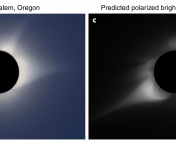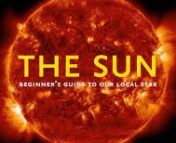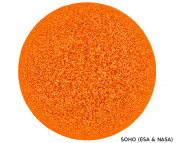On Tuesday morning, April 8 2024, astronomers and sky enthusiasts in North America turned their attention, gaze, telescopes and cameras to the Sun to catch a view of the celestial shadow– a total solar eclipse in many towns and partial eclipse in most of the continent. This event, which was a once-in-a-lifetime opportunity for many umbraphiles, saw a lot of tourists in rural areas, outreach events packed with families, and livestreams with over 10 million viewers tuned in from different parts of the globe. It was estimated that between 1.85 and 7.4 million people travelled to catch the beauty of totality eclipse. The solar eclipse provided a unique opportunity for for solar observations, offering insights into the intricate dynamics of the Earth-Moon-Sun system and allowing solar scientists to explore phenomena such as the solar corona, prominences, and the complex interplay of light and shadow across the solar disk.
Astrobiters were scattered across path of totality and they bring to you the action and views from their respective locations.
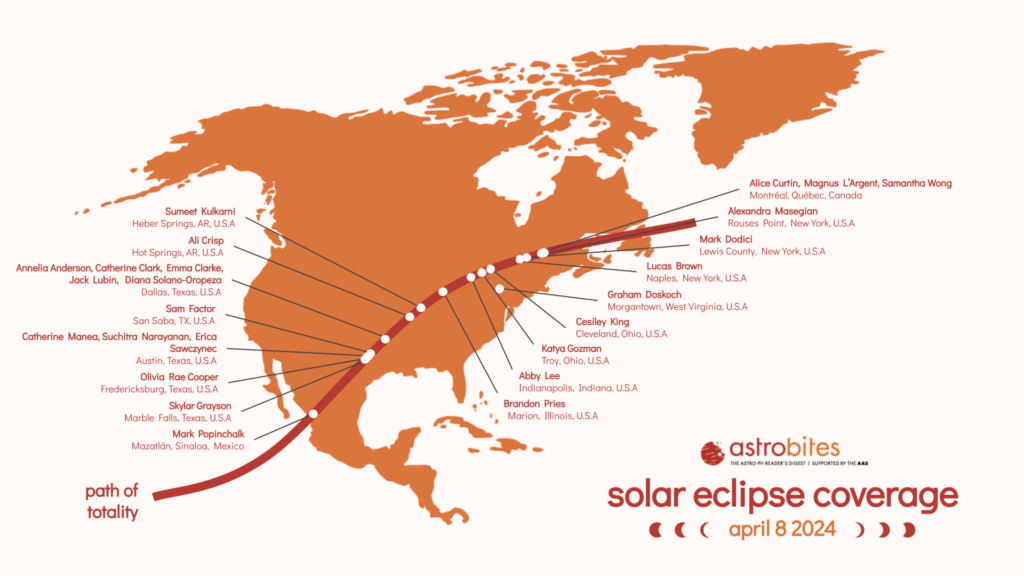
Mazatlán, Sinaloa, Mexico- Mark Popinchalk
The city almost doubled in population, close to 400,000 arriving for the eclipse in the beautiful beach town. We had light clouds, but the eclipse was still spectacular. Folks from Astrofisicos en Acción (early career astronomer run group from Mexico City) had set up their telescopes and were helping people see the eclipse, as well as live streaming it. This was my second total eclipse and I’m already planning the next!

Marble Falls, Texas, USA- Skylar Grayson
I watched the eclipse from a lovely ranch in central Texas. We were convinced there was no chance of seeing the eclipse with cloud coverage, but as the day progressed the clouds got patchier and patchier. During the eclipse itself, the sun would periodically disappear but we got to see it at almost every stage. When totality hit, it was magical. You could hear cheering across the hills as each ranch successively reached totality. We had an 8-inch telescope which allowed us to see the prominence really clearly, and got a beautiful diamond ring effect as the sun began to emerge. I found myself quite emotional and I definitely teared up watching it. We went into the town of Marble Falls later in the day and it was wonderful to see and hear how much being in totality meant to the community. Eclipses are such perfect events to get people excited about space! This whole trip was a memory I’ll treasure forever.
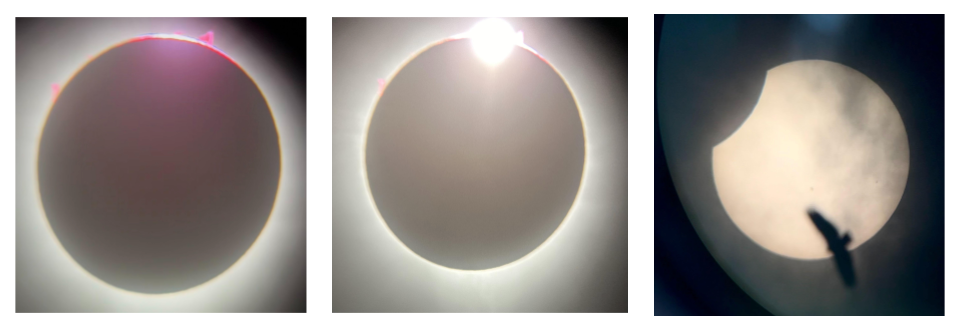
Fredericksburg, Texas, USA- Olivia Cooper
There were 10 of us (and two corgis) sitting in a cow pasture in Texas Hill Country, sprawled out on camping chairs, picnic blankets, and yoga mats. Half of us were astronomers, but that afternoon, we were all expert observers, diligently watching the Moon pass in front of the Sun. We worked together to manifest clear skies and were rewarded with blue patches in the morning, but by the afternoon, it had become pretty overcast. As the crescent of the Sun began to take shape, moments of thinner cloud cover were announced by hollers from a group of campers one field over. The lighting was eerie, making the landscape somehow appear both dimmer and sharper. The longhorns lay down and settled in for the night, at noonish. Then: totality. We had been waiting for this moment all day – and in a way, since 2017 – but were surprised when it happened nonetheless. It got unbelievably dark, and the birds quieted. We all cheered, and I remarked, astonished: “We have four minutes of this!” We relished the midday darkness, and were awestruck by the visible red prominences around the corona, these massive loops of plasma emerging from the surface of the Sun. After our few eclipsed minutes, we looked back down at each other, full of gratitude and wonder for the cosmic orbits that brought our little community together here and now, to witness this special moment in the orbits of the Earth, Moon, and Sun.

San Saba, Texas, USA- Samuel Factor
To avoid the expected nightmare of traffic around Austin, TX a friend and I camped east of the path of totality the night before and after the eclipse. After an early morning drive to Llano, TX we decided the weather forecast looked a bit better in San Saba, TX even though it would be a slightly shorter totality. We ended up finding a park to set up in and made a bunch of friends with my 8” telescope (with a solar filter of course). The skies turned out to be mostly clear and we had a beautiful view of totality that was only slightly interrupted by clouds. The picture I am most proud of was just before the end of totality and captured some amazing prominences.
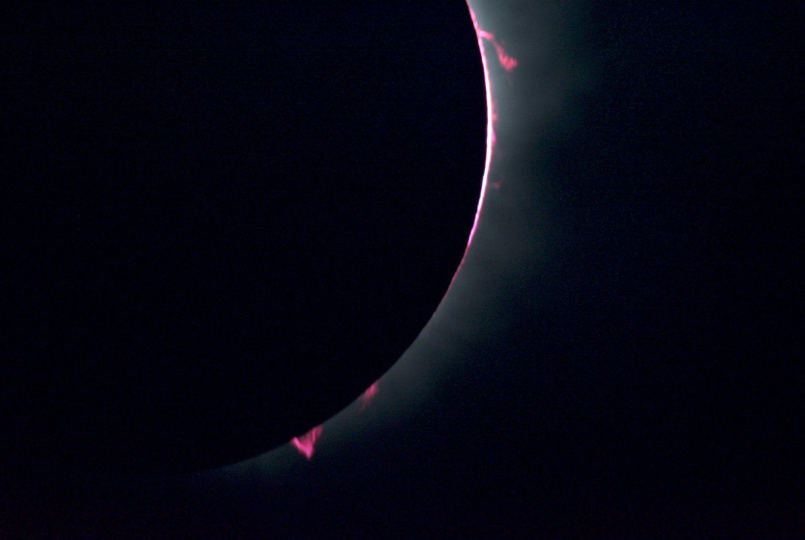
Dallas, Texas, USA
Annelia Anderson
We got lucky in Dallas! The eclipse was visible through a break in the clouds just as totality began. We watched from the quiet backyard of an Airbnb, and even though I technically knew what to expect, my heart stopped when I took my glasses off – it was like a hole in the sky. Planets were visible, and the sky remained clear long enough for the diamond ring to reappear. As astrophysicists, it’s sometimes easy to lose the sense of wonder that initially drove us. I feel so fortunate to have been reminded how bizarrely strange and wonderful our universe is.
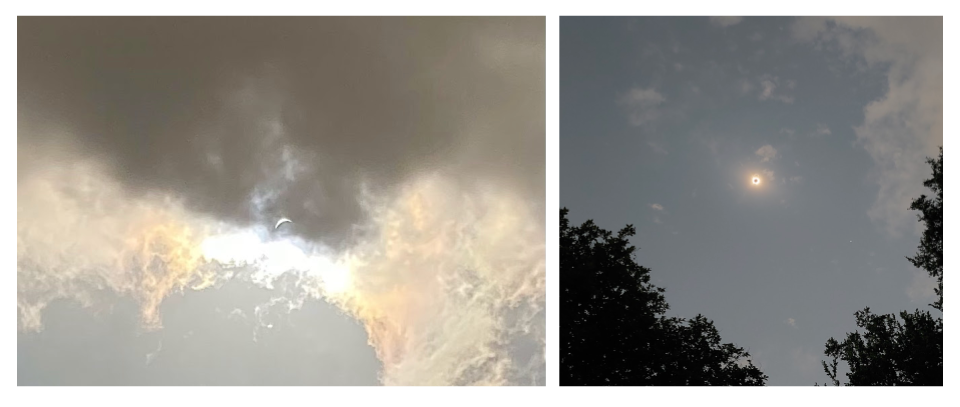
Emma Clarke
In the days leading up to the eclipse, the weather forecast was constantly fluctuating between everything from clear skies to thunderstorms. On the morning of we saw a bit of sunlight and blue sky, but it was shortly overtaken by clouds. About an hour before the eclipse began, some blue sky started to peek out between some clouds. We crossed our fingers that it would stay that way, and our wishes came true! Although the sky was not completely clear, the clouds were passing and the beginning of the eclipse through to the end of totality was visible from my location. It was also bright enough out that the change in brightness was noticeable and incredibly eerie. Shortly after, clouds swept in and blocked the view for a while. I felt very lucky to have had such a clear view for totality!

Jack Lubin
We woke up to a thick blanket of gray clouds and very little hope of seeing the full totality. I went with a crew of 18 family and friends to a lake just northeast of downtown Dallas. There, the clouds began to break but still big flows of dark gray clouds loomed. As the eclipse began, we enjoyed the peaks through the clouds but were anxious. And I assure you, this really happened: in the 10 minutes before totality, a sanitation truck pulled up to the parking lot near us and began emptying the port-a-potties, which gave off quite a smell! Of all days and times to do this! But we quickly pushed that out of our minds as in the last 5 minutes the skies truly opened wide, not a cloud in the sky and we had a perfect viewing! We saw Jupiter and Venus, we saw a large prominence at ~5 o’clock on the face of the Sun, we saw the corona glowing, and before we knew it, it was over. Can’t wait for the next one!
Diana Solano-Oropeza
Like other eclipse hopefuls in Dallas, I woke up to thick clouds hanging over the city, but it cleared up by the time my family and I arrived downtown. After getting to Turtle Creek, the moon began its journey across the sun. I had seen a partial eclipse before, on a cloudy day in Philadelphia in 2017, but this was different. Bit by bit, our Sun disappeared and soon… Everything went dark. Everyone screamed. I threw off my eclipse glasses, and shouted in awe. From 1:40-1:44pm, Dallas bathed in twilight, its city lights outshone by an uncanny white blaze enclosing a sight that would make Soundgarden weep. People sang and cheered – it was better than New Year’s! As I gazed into totality, I thought about my loved ones, including my father, who unfortunately passed away in Dallas a few years ago. He would have loved to see this. I also thought about the exoplanet transits I study, which are similar to eclipses. Maybe somewhere, an exoplanet saw an eclipse too. An outpouring of light – the diamond ring effect – broke my contemplation. Near instantly, it was over, leaving me extremely determined to see totality again and again!
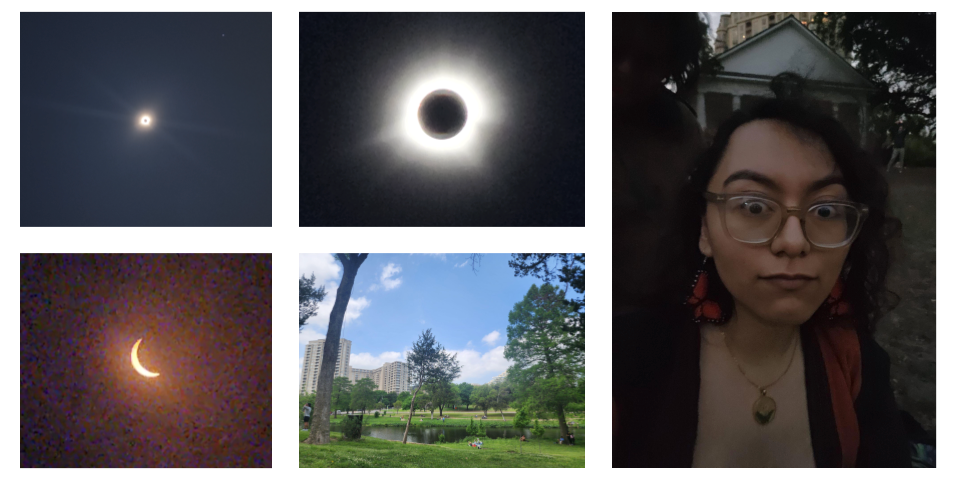
Hot Springs, Arkansas, USA- Ali Crisp
A group from LSU (including myself) had been planning to travel to San Antonio, TX for the eclipse, but as we watched the weather forecast, we ended up nixing those plans. The forecast for Arkansas was looking decent Saturday night and Sunday morning, so Sunday evening, my partner and I took off for my brother’s house outside Little Rock, while another LSU group went straight to Hot Springs, and the rest headed to Illinois. Monday morning, we drove towards Hot Springs without much of a plan. While trying to find a place to park, we were waved into a parking garage where someone had just left and were able to get their spot. We spent the rest of the time until totality setting up my camera and chatting with the rest of the people viewing the eclipse from the top of this parking garage, including a group of astrophotographers from Mississippi and a couple from North Carolina. The husband turned out to be an emeritus physics professor – Dr. Wolfgang Christian – who is big in open source physics education, so that was a cool coincidence for an Astrobites member! At 1:45 we were at about 97% totality, it was significantly darker, and all the people and birds had gone quiet. A nearby church bell started chiming the quarter-hour and echoed eerily across the town. When it reached totality, everyone watching started cheering, and the fire department set off the sirens on their trucks. This was my first time witnessing totality, and the experience was 10000% worth driving 14 hours round trip for ~3.5 minutes.
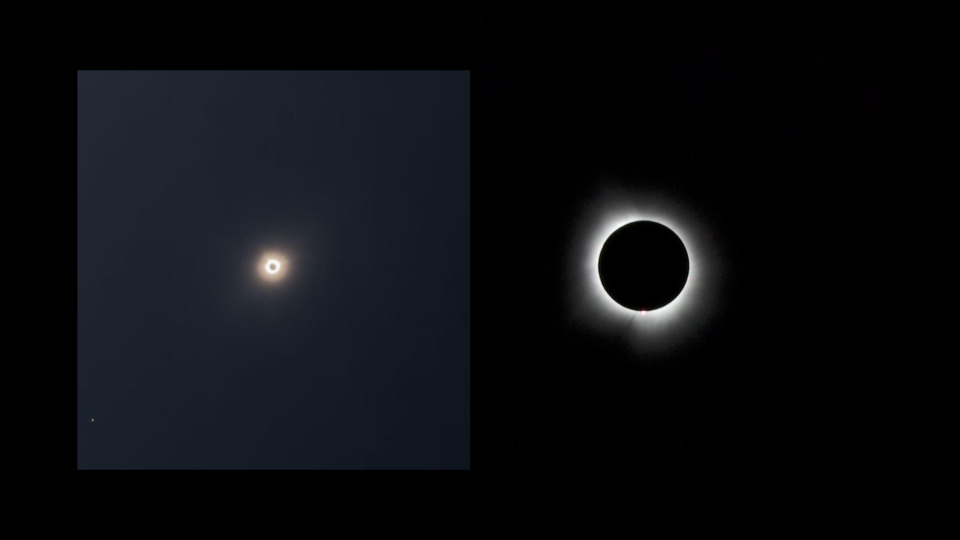
Heber Springs, Arkansas, USA- Sumeet Kulkarni
The portion of totality closest to our home in Oxford, MS turned out to have favorable weather on Monday, so I headed out with my partner, advisor, and colleagues towards northern Arkansas at 6 am. We reached Heber Springs, a small town next to a dam two hours before totality, and immediately regretted not having packed any sunscreen. After an hour of fanning ourselves, nature’s best sunscreen got to work, gradually dimming and cooling the surroundings. We enjoyed 4 minutes of cloudless totality, half of which I spent clicking pictures, and the other half just soaking everything in. 4 minutes passed by quickly. In totality, any amount of time is a very short time. I captured audio from before and after totality, which features all kinds of animals freaking out, either verbally or non-verbally. Afterwards, I interviewed some eclipse viewers who had come from as far as Texas, Oklahoma, Mississippi, and even Switzerland and recorded their comments for a story I’m reporting.

Marion, Illinois, USA- Brandon Pries
Our group had a great time! We were at Crab Orchard Wildlife Reserve in Marion, IL. We set up some telescopes on a concrete platform in front of an old WWII ammunition bunker, and the telescopes provided some great views. We kept talking about how odd things felt as the partial eclipse got heavier: the weather got noticeably colder and windier; all the bugs in the area seemed to think night was approaching; and everything seemed dimmer like sunrise/sunset, but not redder (since the solar spectrum stayed the same) – it seemed to get bleaker as if someone kept turning down the saturation. We got to experience totality for about 4 minutes starting right around 2:00 p.m. local time. It was awesome! I didn’t get any great photos myself, unfortunately, but I’ll share some good ones from other folks in our group. I’m looking forward to the next one!
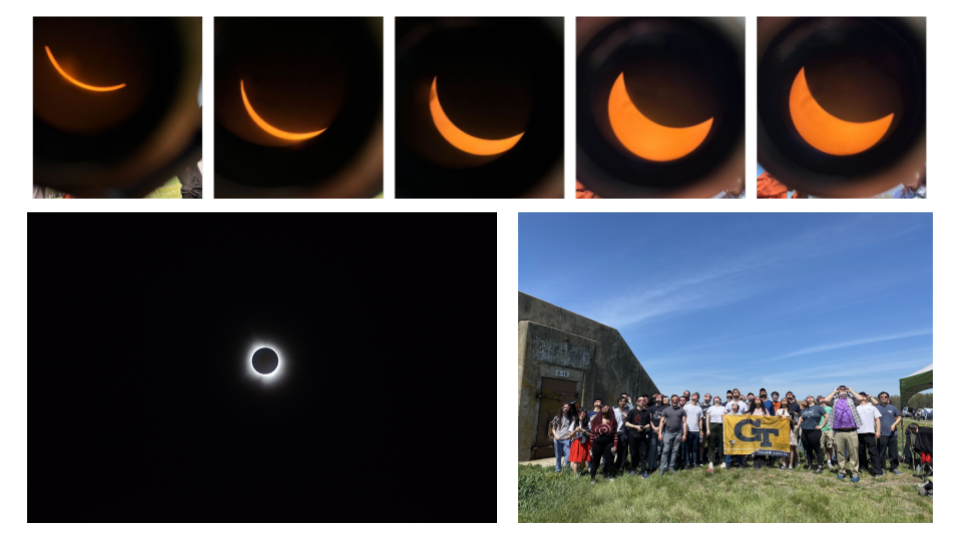
Indianapolis, Indiana, USA- Abby Lee
I witnessed the total eclipse for the first time with some of my best friends from college who flew in from all over the country! The weather was good– a little hazy at about 40% cloud cover but the view was still spectacular. Experiencing totality brought tears to my eyes– the eclipse is the most amazing thing I have ever witnessed. It feels like a bug in the code of the making of the Universe. It was also so cool to hear strangers from all over the neighborhood cheering during the moment totality began.
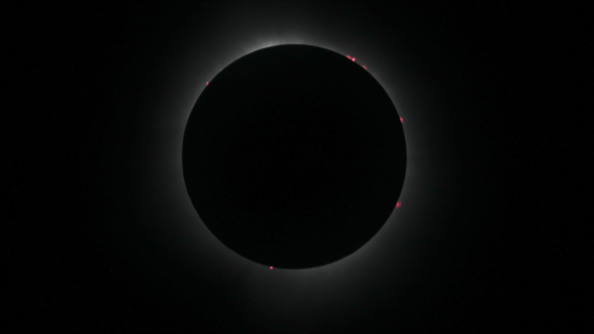
Morgantown, West Virginia, USA- Graham Doskoch
Out of the path of totality but primed for ~95% coverage, I worked on a community outreach event as a part of the West Virginia University Planetarium. We brought in telescopes with solar filters, organized undergraduate posters on the scientific and cultural impacts of solar eclipses in history, and distributed ~1100 eclipse glasses in the first five minutes. Missing totality stunk, but helping hundreds of people appreciate an awesome event was rewarding. The gasps when we reached maximum coverage, the kids looking through solar filters, the dogs wearing eclipse glasses – it was something I won’t forget.
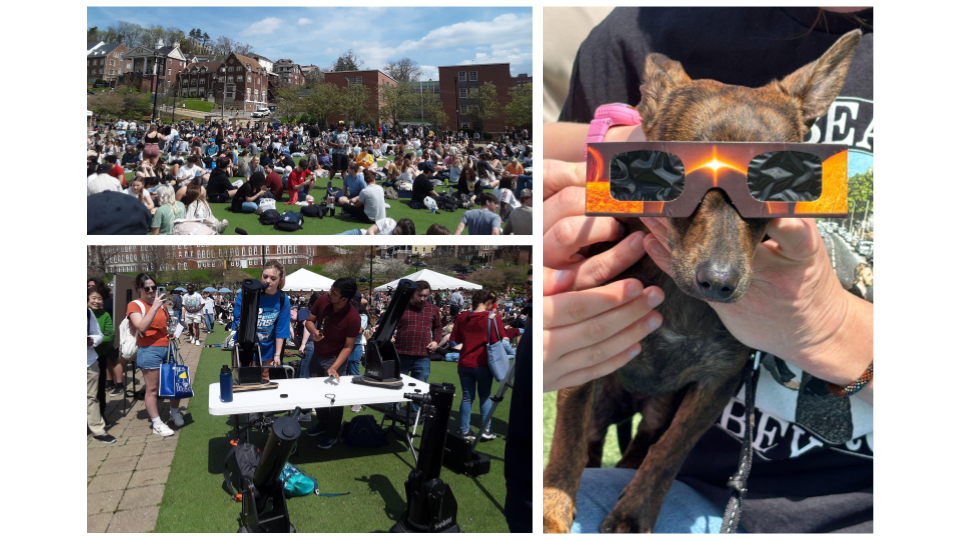
Cleveland, Ohio, USA- Cesiley King
Although we woke up to discouragingly cloudy skies, by the afternoon, the clouds had fortuitously cleared and we had terrific viewing conditions for the eclipse. My lab mates, some additional colleagues, and I gathered on the roof of a building on Case Western Reserve University’s campus to witness the eclipse, and some folks even captured the event with impressive astrophotography setups. I managed to snap some eclipse photos with my own makeshift setup that secured one of the lenses from a pair of eclipse glasses in front of my mobile phone’s camera lens, but witnessing totality with my own eyes was a breathtaking experience. As the sky first darkened, we cheered, but then we gazed upon the eclipse in awestruck silence for the remainder of the 4 minute totality.

Naples, New York, USA- Lucas Brown
Knowing full well that the chances of good weather in western New York were always going to be slim in early April, five of my friends and I planned to go to Naples for the eclipse so we could take advantage of one of their family’s remote cabin overlooking one of the Finger Lakes. Despite beautiful and completely clear weather conditions on both preceding days, on Monday morning a wispy layer of clouds turned gradually thicker and more ominous until we began to get actual rainfall. While this seemed like it would make for a worst-case-scenario viewing experience, it actually turned into a somewhat magical and unique one. As the skies darkened, there was a calming mixture of soft rain patter, bird-song, and frogs croaking as if it were truly approaching dusk. During totality, the sky was black other than a soft orange glow backlighting the distant hills. Looking back at a time-lapse I took of the valley, the cloud cover actually turned out to provide a great canvas on which one could clearly see the moon’s shadow moving rapidly overhead towards the Northeast.
Despite experiencing these “non-ideal” eclipse viewing conditions, I actually found the whole thing to be quite special—and it was great to have spent the weekend at a cabin with friends rather than driving around trying to chase some faraway patch of blue sky.
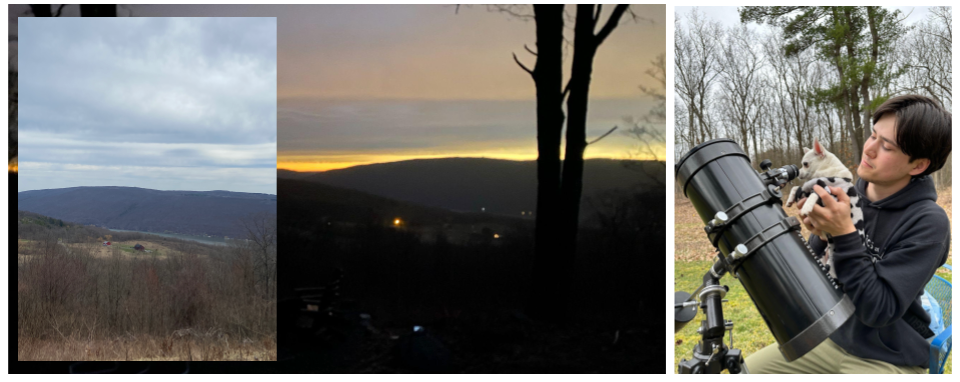
Lewis County, New York, USA- Mark Dodici
Upstate NY got a little unlucky! After a good forecast as recently as last Friday, weather models for Monday showed a cloud front encroaching further and further into the state from the west. Today, that front more or less covered the path of totality. We chased some patches of blue sky north and east into the foothills of the Adirondacks, ending up just north of Croghan, but the clouds kept coming.
And yet, it was fantastic. For totality, we found ourselves in a little clearing in a quiet forest accessed by a dirt road, and the silence of the woods in the moments before and during was stunning in itself. Instead of a “diamond ring,” we got something that looked like a huge flashlight shining from the other side of the clouds. Then, finally, all went dark, and the corona — as bright as a full moon — made itself known.
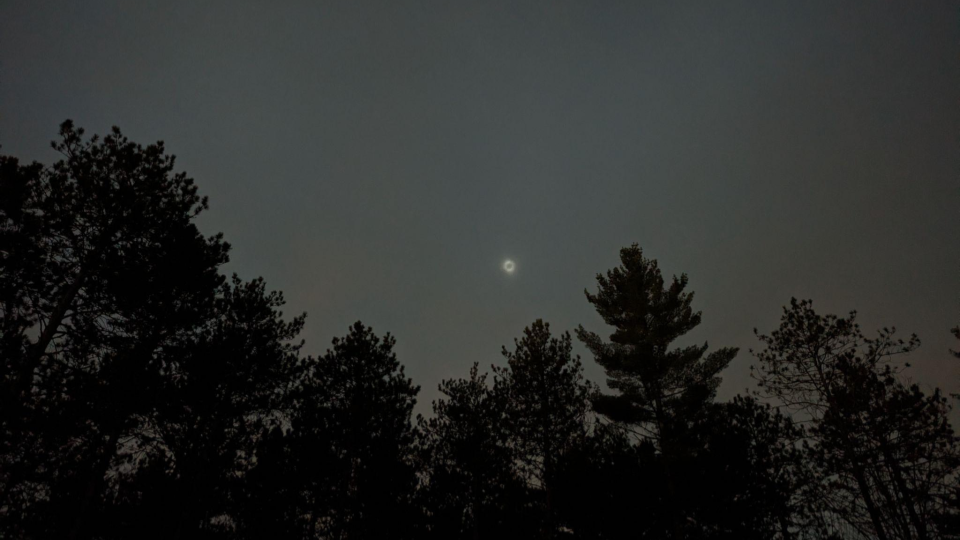
Rouses Point, New York, USA- Alexandra Masegian
My partner and I had originally planned to travel to Dallas, but with the weather looking iffy, we changed our plans last minute and drove due north from NYC on Sunday night. The only hotel room we could find was still an hour south of the path of totality — everything else was fully booked! We woke up before the sun on Monday morning to drive to Rouses Point, NY, a tiny town in the upper right corner of New York very close to the Canadian border. There, we camped out on a small boat launch in the middle of Lake Champlain to wait for totality. Despite the remote location, we were soon joined by dozens of other eclipse-chasers, who watched warily alongside us as wispy clouds crept up over the horizon. When the partial eclipse began, we all shared telescopes and binoculars to watch the moon slowly cover the disk of the sun. We even saw a few sunspots and a rainbow-colored ice halo! In the minutes before totality, we saw the moon’s shadow racing towards us from the horizon, darkening the mountains in the distance before finally reaching our viewing spot. The sun shrank to a pinprick, a bright diamond on the ring of the moon, before vanishing entirely as totality began. Thin clouds prevented us from seeing stars, but we saw Venus and Mercury, as well as the sun’s spectacular corona and multiple reddish prominences. We enjoyed three and a half minutes of totality before the shadow receded as quickly as it had come, racing away up to Maine and Canada. It was without a doubt the most incredible natural phenomenon I have ever witnessed. Eclipse traffic nearly doubled the length of our five-hour drive home, but the experience was worth every minute.
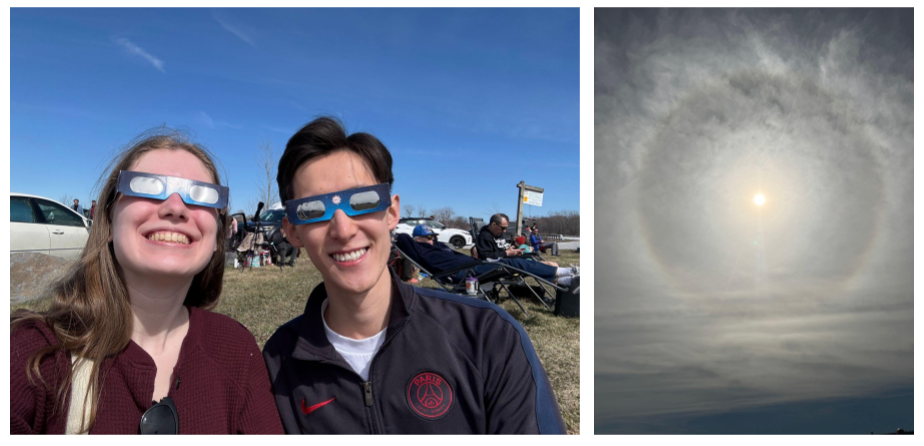
Montréal, Québec, Canada– Alice Curtin, Marcus L’Argent, and Samantha Wong
It was absolutely clear skies in Montreal! We helped in organizing a large eclipse fair at the Trottier Space Institute at McGill. We handed out over 15,000 pairs of glasses and welcomed >50,000 people to McGill. There were lots of activities ranging from physics demos to building your own pinhole camera. It was really special being with such a large group of people during the eclipse as people were gasping in awe together.
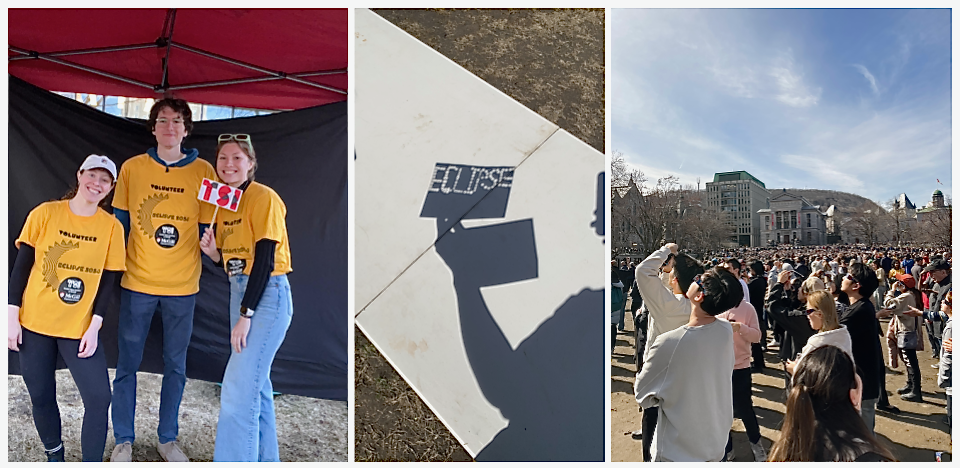
Compiled by Maria Vincent
Featured Image Credit: Lucas Brown
All images provided by Astrobites authors at respective locations, unless otherwise specified.

